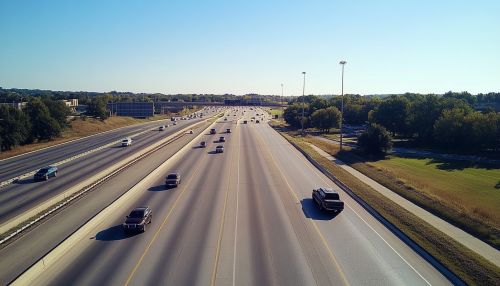National Highway Traffic Safety Administration: Difference between revisions
(Created page with "== Overview == The National Highway Traffic Safety Administration (NHTSA) is an agency of the United States federal government, part of the Department of Transportation (DOT). Established in 1970, the NHTSA is responsible for ensuring the safety of motor vehicles and road users in the United States. Its primary functions include setting and enforcing vehicle performance standards, conducting vehicle recalls, and providing grants to state and local governments to promote...") |
No edit summary |
||
| Line 75: | Line 75: | ||
4. **Strengthening Partnerships**: Collaborating with stakeholders to leverage resources and expertise for maximum impact. | 4. **Strengthening Partnerships**: Collaborating with stakeholders to leverage resources and expertise for maximum impact. | ||
[[Image:Detail-98885.jpg|thumb|center|Scenic view of a highway with vehicles traveling under a clear blue sky.|class=only_on_mobile]] | |||
[[Image:Detail-98886.jpg|thumb|center|Scenic view of a highway with vehicles traveling under a clear blue sky.|class=only_on_desktop]] | |||
== See Also == | == See Also == | ||
Latest revision as of 05:55, 21 October 2024
Overview
The National Highway Traffic Safety Administration (NHTSA) is an agency of the United States federal government, part of the Department of Transportation (DOT). Established in 1970, the NHTSA is responsible for ensuring the safety of motor vehicles and road users in the United States. Its primary functions include setting and enforcing vehicle performance standards, conducting vehicle recalls, and providing grants to state and local governments to promote highway safety. The agency also conducts research on driver behavior and traffic safety, aiming to reduce traffic crashes, fatalities, and injuries.
History
The origins of the NHTSA can be traced back to the Highway Safety Act of 1966, which was enacted in response to increasing public concern over the rising number of traffic fatalities. The Act led to the creation of the National Highway Safety Bureau, the predecessor to the NHTSA. In 1970, the NHTSA was formally established as part of the Department of Transportation, with a mandate to improve vehicle safety and reduce traffic-related deaths and injuries.
Mission and Objectives
The mission of the NHTSA is to save lives, prevent injuries, and reduce road traffic crashes. The agency's objectives include:
1. **Vehicle Safety Standards**: Developing and enforcing Federal Motor Vehicle Safety Standards (FMVSS) to ensure that vehicles meet minimum safety requirements. 2. **Research and Data Collection**: Conducting research on vehicle safety technologies, driver behavior, and road conditions to inform policy and regulatory decisions. 3. **Public Education and Awareness**: Implementing campaigns to educate the public on safe driving practices, such as the "Click It or Ticket" seatbelt campaign. 4. **Vehicle Recalls and Defects**: Overseeing the recall of vehicles with safety defects and ensuring that manufacturers comply with safety regulations. 5. **Grant Programs**: Providing funding to state and local governments to support traffic safety initiatives, such as impaired driving prevention and pedestrian safety programs.
Regulatory Framework
The NHTSA operates under a comprehensive regulatory framework that includes the National Traffic and Motor Vehicle Safety Act and the Highway Safety Act. These laws grant the agency the authority to establish vehicle safety standards, conduct investigations, and enforce compliance. The NHTSA's regulations cover a wide range of safety aspects, including crashworthiness, crash avoidance, and post-crash survivability.
Federal Motor Vehicle Safety Standards (FMVSS)
The FMVSS are a set of regulations that specify minimum safety performance requirements for motor vehicles and equipment. These standards address various safety features, such as airbags, seatbelts, braking systems, and lighting. The NHTSA regularly updates the FMVSS to incorporate new safety technologies and address emerging safety issues.
Vehicle Recalls
The NHTSA has the authority to initiate vehicle recalls if a safety defect is identified. The agency works closely with manufacturers to ensure that defective vehicles are repaired or replaced. Vehicle owners can check for recalls using the NHTSA's online database, which provides information on open recalls and safety issues.
Research and Innovation
The NHTSA conducts extensive research to advance vehicle safety technologies and improve road safety. The agency's research focuses on several key areas:
1. **Automated and Connected Vehicles**: Exploring the potential of autonomous vehicles and vehicle-to-vehicle communication to enhance safety and reduce traffic congestion. 2. **Crashworthiness and Crash Avoidance**: Investigating new materials and designs to improve vehicle crashworthiness and developing technologies to prevent crashes, such as automatic emergency braking. 3. **Human Factors and Driver Behavior**: Studying driver behavior, distraction, and impairment to develop strategies for reducing risky driving practices. 4. **Data Collection and Analysis**: Collecting and analyzing crash data to identify trends and inform policy decisions. The NHTSA operates the Fatality Analysis Reporting System (FARS), which provides comprehensive data on traffic fatalities.
Public Education and Outreach
The NHTSA is committed to educating the public on traffic safety issues through various campaigns and initiatives. These efforts aim to raise awareness and encourage safe driving behaviors. Key programs include:
1. **Seatbelt Safety**: The "Click It or Ticket" campaign promotes seatbelt use through enforcement and public awareness efforts. 2. **Impaired Driving Prevention**: Initiatives such as "Drive Sober or Get Pulled Over" target drunk and drug-impaired driving. 3. **Distracted Driving Awareness**: Campaigns like "U Drive. U Text. U Pay." aim to reduce texting and other distractions while driving. 4. **Child Passenger Safety**: The NHTSA provides resources and training to ensure the proper use of child safety seats and booster seats.
Grant Programs and Partnerships
The NHTSA administers several grant programs to support state and local traffic safety initiatives. These grants fund a variety of programs, including:
1. **Highway Safety Grants**: Funding for state programs that address issues such as impaired driving, seatbelt use, and pedestrian safety. 2. **Traffic Safety Information Systems Grants**: Support for the development and enhancement of state traffic safety data systems. 3. **Emergency Medical Services Grants**: Assistance for improving emergency medical services and trauma care for crash victims.
The NHTSA collaborates with other federal agencies, state governments, industry stakeholders, and non-profit organizations to advance its safety goals. These partnerships are essential for leveraging resources and expertise to address complex traffic safety challenges.
Challenges and Criticisms
Despite its successes, the NHTSA faces several challenges and criticisms. Some of the key issues include:
1. **Resource Constraints**: Limited funding and staffing can hinder the agency's ability to effectively carry out its mission. 2. **Regulatory Delays**: The process of developing and implementing new safety standards can be slow, leading to delays in addressing emerging safety threats. 3. **Technological Advancements**: Rapid advancements in vehicle technology, such as autonomous vehicles, present regulatory challenges and require the NHTSA to adapt quickly. 4. **Public Perception**: The agency must balance its role as a regulator with the need to maintain public trust and confidence in its safety initiatives.
Future Directions
The NHTSA is focused on addressing current and future traffic safety challenges through innovation and collaboration. Key priorities include:
1. **Advancing Vehicle Automation**: Developing policies and standards to support the safe deployment of autonomous vehicles. 2. **Enhancing Data Collection and Analysis**: Improving data systems to better understand crash causes and inform safety strategies. 3. **Promoting Equity in Transportation Safety**: Ensuring that traffic safety initiatives address the needs of all road users, including vulnerable populations. 4. **Strengthening Partnerships**: Collaborating with stakeholders to leverage resources and expertise for maximum impact.


